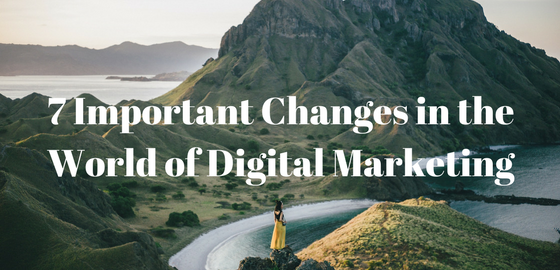Digital marketing has been around for quite some time now, but due to progress in technology, it continues to change. It is good to check those changes every now and then. In fact, the digital world is evolving faster than most businesses can adapt. I have recently read two articles regarding changes in digital marketing that I thought would interest you.
In an article of April 16, 2017, Scott Rigby identifies 4 key areas that are essential to the strategies of the most digitally mature companies and lists the best practices tied to these four key areas. Similarly, in an article of March 19, Nadav Olmert identifies 7 significant changes to digital marketing.
Reading about these changes will help you understand where your company stands in terms of digital marketing trends. Will you have to adjust your strategy or are you leading those trends?
4 key areas essential to digital marketing strategies
Every year, Adobe conducts a survey to explore trends and priorities in digital marketing and to understand where the market is headed. As mentioned, Rigby and his team have identified four key areas that are essential to the strategies of the most digitally mature companies: data-driven marketing, customer experience, mobile, and cross-channel marketing. Rigby urges you to keep in mind that no single element is more important than another; each element needs to be in balance with the others to sustain your business’s online success.
1. Data-driven marketing
Use data to gain insights into your customers and turn this knowledge into action. Here are 4 best practices:
- Use customer data to understand and personalize each individual’s journey
- Invest in predictive analytics
- Centralize your data to accelerate insights and for ease of accessibility
- Integrate external and offline data to enhance your audience segments
2. Customer experience
Create more meaningful experiences and move your organization forward to digital maturity. Here are 4 best practices:
- Think of every touchpoint as a brand connection
- Develop content with the customer’s needs in mind
- Work to develop a rich customer profile
- Automate the delivery of your personalized content
3. Mobile
Prepare for a mobile-only world. Here are 4 best practices:
- Make mobile a priority by investing in mobile channels and applications
- Create dedicated mobile sites and apps
- Use data to determine the value your mobile channels deliver
- Use data to understand valuable mobile content and services
4. Cross-channel marketing
Start your organization’s conversation about delivering a consistent message across all channels. Here are 4 best practices:
- Invest in technologies, processes, and tools for connecting at every point in the customer journey
- Adapt your message for each channel while ensuring a cohesive story across all channels
- Integrate your systems and channels to share data as well as content and assets
- Invest in tools to understand your customer’s journey
7 important changes to digital marketing in 2017
What can we expect of digital marketing in 2017? In January, I asked the same question in my blog called ‘What Will be the Digital Marketing Trends of 2017?’ In it, experts agreed and disagreed on a few trends that they thought digital marketing would bring us in 2017 (or not). With all the changes rapidly succeeding each other, it is not strange to revisit the same question four months later. Here is what Olmert has found:
1. Cognitive AI marketing: What is next is already here
AI marketing uses machine learning algorithms in order to make better decisions based on big data. AI systems could have a profoundly disruptive impact on digital marketing as the possibilities are endless. With cognitive AI, you will be able to set your marketing system to predict goal-orientated information automatically and even set up business campaigns on multiple channels based on complex behavioral targeting.
2. Screenless SEO
More and more smart speakers by Amazon and Google are being sold. These devices provide a screenless voice interface with the largest search engines available, allowing the user to search and compare different products. Remotely controlled by voice, these devices are paving the way for a whole new SEO tactic based solely on natural spoken language. Content marketers will have to aim for content in a conversational manner.
3. Personalization
A/B testing has become a widely-used method among professional marketers to evaluate changes done to a website’s visual interface and how they, in turn, affect the users’ conversion rate. Personalization tools allow you to take the personalization of the user experience to a whole new level; you can experiment with the different ways in which you can manipulate websites’ interfaces to fit each individual user’s personalized wants and needs.
4. Psychographic segmentation
The ability to pinpoint and identify users based on geographics and demographics as well as the immediate availability of data has real potential to reshape the world of marketing. We already know that consumers tend to look towards others to evaluate if a product is worth purchasing. By taking advantage of today’s ability to dissect and analyze data, we can determine exactly what type of psychographic behavior our audience displays. The ability to tailor the right message to the right audience is absolutely crucial in order to attract a large customer base.
5. Facebook is KING
Facebook has made quite some adjustments that you can use as a digital marketer.
Facebook just introduced a new lead capturing feature that marketers can use on their Facebook ads: Lead Ads. With Lead Ads, you can create and customize ads, requesting that visitors submit different kinds of information, such as e-Email address, zip code, and phone number. Information entered into this system can be downloaded and processed to increase the reach of marketing campaigns.
Facebook Chatbot Analytics: A chatbot is a computer program that initiates conversation with users over a platform like Facebook Messenger. Increasingly more marketers are starting to identify how this tool could disrupt marketing on social networks. In order to analyze and understand the degree to which these bots are affecting conversion rates, Facebook has announced a new analytics feature that will assist marketers to evaluate their efforts. Even so, in the near future organizations will still need to put an emphasis on human to human interactions and allow for a natural conversation flow with their customers.
Facebook Live has definitely done a better job at getting more people to engage with their news in real time. Livestreaming is a hot trend to connect brands and customers and it increases engagement by 175%. Use Facebook live to engage your target audience and to promote your products and services.
6. WhatsApp for Businesses
In fall 2017, WhatsApp is expected to launch a new update that will allow businesses to join the messaging platform and establish company profiles. That is great news because the average consumer checks one’s phone 150 times per day, and checks for texts every 10 seconds. Whatsapp is also aiming to bring a rich array of new features that will allow individuals to shop, chat, and stay updated while using the most instinctive app on their smartphone.
7. Brand new (updated) tools by Google
Google has released a few major updates to its business suite. Among the various improvements, Google has combined the dashboard, custom reports, and custom alerts into one tab. In addition, Google has replaced its intelligence events with an Automated Assistant. In March 2016, Google announced the release of Google Optimize 360: a landing page, A/B testing, and optimization tool that integrates directly with Google Analytics.
I hope that these key elements, best practices, and (announced) tools and improvements help you update your digital marketing strategy.
Digital & Social Articles on Business 2 Community(82)
Report Post






